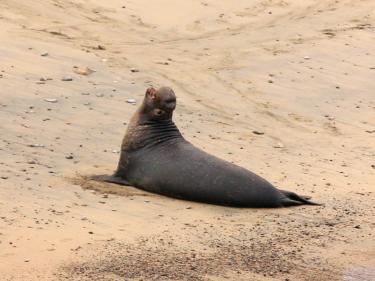Outdoor Safety for Families: Poison Oak is Not Your Friend
With our copious amounts of rainfall this season, it's little wonder that we're seeing lush amounts of vegetation in Marin's forests and meadows. Unfortunately, much of this otherwise beautiful greenery is in the form of poison oak, an irritating plant that anyone participating in outdoor activities this summer should be wary of, especially children who may not be on the lookout for this distinctive shrub with leaves grouped in threes.
Please note that this post should not be a substitute for proper medical advice—if you suspect that someone in your family has developed a reaction to poison oak, go see your doctor or a dermatologist.
Western or Pacific Poison-oak (Toxicodendron diversilobum), is found all along the west coast, from Baja California to southern Canada, and is one of the most common plants seen around trails and campsites in California. It's also one that just about everyone really wants to avoid. Anyone who's ever had poison oak will tell you that the old axiom "Leaves of three, let them be" is something to live by. Most of the year, this plant has distinctive, shiny leaves grouped in threes. Bright green in the spring, they turn reddish in the summer, and by fall they're a bright and not unattractive red or pink. This plant can be found in shrub form, often in large amounts, or in vine form climbing up and around trees. It's not actually related to the oak tree (which is why it's officially spelled "Poison-oak,"), although the leaves look a little similar, but it's often seen on and around oak trees.
The "poison" in poison oak is a noxious substance called urushiol. The first symptom of contact with poison oak is a severe itch, accompanied by either a red rash, colorless bumps, or both. This irritation later breaks out into blisters. Scrathing the blisters can cause them to ooze fluid, which, contrary to urban legend, does not spread the poison oak on the victim's skin or to other people. The urushiol bonds quickly to the skin, and once it does, you're pretty much guaranteed to develop the rash, unless you're one of the lucky few who is not affected by poison oak (it's estimated that 15–30% of the population is not allergic to poison oak, but a sensitivity can build up over time, so it's best to avoid it no matter what). If you know you had contact with poison oak, you can alleviate some of the effects by washing the affected area immediately with cool water, but this is not a guarantee that you won't be affected by it.
How can you avoid poison oak? Make sure you stay on marked paths and trails, and avoid contact with the plant or anything that's touched it. The oils from poison oak can last for a long time, and you can pick up a nasty case of poison oak by touching something else that was exposed, such as clothing, tools, and of course the family pet. (Ever wonder where your cat goes during the day?) Just last month I picked up a case of poison oak after taking a mountain bike ride with my son. The rash and bumps showed up on my arms, and since I had been wearing a long-sleeve shell on the ride, I must have made contact with the oils when touching something else like my bicycle or clothing that my son or I wore on the ride.
I've heard rumors, or possibly urban legends, that extreme heat can cause poison oak oils to become airborne, so cases of poison oak can be picked up just by being in close proximity to the plant. Again, I'm not sure this is true, but I'm in no hurry to test the theory. Apparently poison oak is even worse when ingested or inhaled in the form of smoke (a particular hazard for wildfire-fighting crews).
If you think you or your children have been exposed to poison oak, it's best to bathe or shower as soon as possible in lukewarm water, and wash all clothing immediately. I've read that washing does not necessarily rid clothing of all urushiol, so you could potentially be re-exposing yourself to poison oak each time your wear an affected garment, no matter how much it's been washed. Some also suspect that laundering poison oak contaminated clothing with other items can actually spread the oils around the entire laundry load, potentially subjecting the entire family to exposure. Again, neither of these things has ever happened to me (at least I don't think they have), so take them with a grain of salkt.
Poison oak is annoying, irritating, and uncomfortable, but generally not life threatening. Various over-the-counter remedies can be used to help alleviate the itching. If you had poison oak or poison ivy as a kid, your mom probably slathered you with that yucky pink calamine lotion; apparently it doesn't do anything, so you can skip that. Oatmeal baths help sooth the skin, and antihistimines like Benadryl can help control the itching. These and other poison oak remedies will only alleviate the discomfort caused by poison oak, not get rid of the rash itself. If you or your children come down with a case, you'll probably just have to ride it out, which takes about two weeks. For very severe cases of poison oak, doctors can administer an injection of powerful anabolic steroids that will get rid of the rash, but this is not without its own risks and should be the path of last resort.
Here are some links to poison oak info online:





